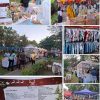Goa is abuzz with excitement as vintage bike and car owners, users, collectors and fans are decking […]

RESTORE EQUAL STATUS TO ROMI!
Aug 10- Aug 16 2024, Cover Story August 9, 2024By Rajan Narayan
THE historical blunder must be corrected. Romi Konkani must be restored its status as equal official language of Goa. This would be belated recognition of the critical role Romi Konkani has played in the Liberation of Goa. All through the 500 plus years of Portuguese colonialism it is Romi script or alphabet which preserved Konkani in Goa.
The Portuguese colonial regime ruthlessly suppressed local native languages, particularly Konkani. The Hindu population of Goa embraced neighboring state Maharashtra language of Marathi as the language of religion and culture. This was not because of any love for Marathi, most Goans have enormous love for their own native Konkani mai bhas or mother tongue. However, as in many other places across the world native languages did not have a script but were only spoken languages in differing dialects. The biggest handicap of Konkani historically is that it did not have its own script.
The Catholic population of Goa adopted Romi Konkani as their script (using the English alphabet). The so called Nagri Konkani, is an imposition by the Saraswat mafia. The Nagri script was a creation of the historian GD Kosambi and it is less than a 100 years old. It is GD Kosambi and his followers who developed Konkani in the Devanagari script.
However, the bitter truth is that the overwhelming majority of the Goan Hindu population stuck to Marathi for not only religious and cultural practices but for education. Even if their mother tongue was Konkani, Hindu Goans may speak in Konkani at home but since they had no script to fall back on they took to the Marathi Devanagri script for reading, writing and other practical purposes.
GOAN CATHOLICS FOR ROMI KONKANI
IN contrast, the sizable Goan Catholic population embraced Konkani in the Romi script. At the time of Liberation Catholics accounted for 40% of the population of Goa. Konkani culture was preserved and promoted in Goa majorly by the Catholic population. It was the dramatic art form of tiatr which helped keep Konkani stay alive and preserve through the colonial years.
The earliest books in Konkani were in Romi Konkani and not in Devanagiri. Among the earliest grammar books in Konkani were the books of Fr Thomas Stephan. Fr Thomas Stephan was the Jesuit priest instrumental in preserving and promoting the Konkani language. The “Krista Purana” is a classic Konkani book written as far back as in the 1590s. Fr Thomas Stephan Konkani Kendrya continues to preserve the legacy of Romi Konkani.
Similarly, it is Goa’s traditional and often highly politicized tiatr drama which helped Konkani stay alive and kicking in Goa. The Goan cultural art form of tiatr is akin to say Indian opera, created or originated in the 19th century, and it became a vehicle of protest against the Portuguese colonial regime.
Konkani tiatr is unique and it is often satirical in its criticism of the government of the day. In fact, Konkani tiatr and its plays have been a powerful tool for social change too. The tiatr originated in Mumbai and spread through the entire Konkani-speaking world. Konkani tiatr continues to be extremely popular among all sections of the Goan population. In contrast, Hindu Goans are still addicted to Marathi natak and there have been very few natak in Devnagiri Konkani.
MARATHI LOBBYISTS
IT IS historical incidental that Konkani in the Devnagiri script became the official language of the state of Goa. Right from Liberation the Marathi lobby of Maharashtra dominated Goa’s politics and culture in Goa. It was not secular democratic party — the Congress — which formed the first government of Goa post-Liberation. It was the Maharashtrawadi Gomantak Party (MGP) which won the majority of seats in the first elections held in Goa after Liberation and much to the shock of the Congress party.
Goa’s very popular first chief minister, Bhausaheb Dayanand Bandodkar, consolidated the position of Marathi. Prior to Liberation, there were no Konkani or Marathi or even English schools in Goa. There were schools only in the Portuguese language. Indeed, literacy was limited to a small section of the Hindu population. The mass of people had no access to education.
It was Dayanand Bandodkar who post-Liberation started over a 1,000 primary schools in the Marathi-medium, within the first year of becoming the chief minister. He wanted to educate Goan children. It was much later that the Diocesan Society started the first English- medium schools in Goa in the late 19th and 20th century. The schools were established by the Roman Catholic Church more with a view to popularize Christianity than to spread education.
By the turn of the century parents and students began switching from the Marathi-medium schools to English- medium schools. To protect Marathi schools the then education minister Shashikala Kakodkar stopped government grants to English medium Diocesan school. This forced the Diocesan school to switch to Konkani in the Devanagari script. This could not be sustained as the church schools did not have the infrastructure to teach in the Devanagari script. Enrolment in the Diocesan school fell sharply.
DIOCESAN SCHOOLS
FINALLY, the church struck a deal with the Chief Minister Digambar Kamat to extend grants to English-medium Diocesan schools. This was ratified by Manohar Parrikar when he became chief minister in 2012. Ever since the number of Marathi- medium primary schools has been on the decline. There are reportedly less than 10 Marathi-medium primary schools at present in Goa. In contrast there is been a huge increase in the number of English- medium primary schools.
It must be acknowledged that it was the Catholic minority community which led the battle for Konkani to be recognized as the official language. They were supported by a small group of Devnagiri Konkani supporters led by advocate Uday Bhembre and some other GSB writers. The government continued to be controlled by the Marathi lobby though Pratapsingh Raoji Rane was a Congress nominee. Rane strongly resisted the demand to make Konkani the official language. Indeed, the bulk of the then Rane cabinet in 1987 was against Konkani.
To the extent that Prime Minister Rajiv Gandhi had to depute a High Command Observer, RL Bhatia, to ensure that the official language bill was passed. Pratapsingh Raoji Rane collaborated with Ramakant Khalap of the Maharashtrawadi Gomantak Party. Rane and Khalap fixed the official language bill to ensure that Marathi got equal official language status. Recently, Khalap has confirmed that the objective of the official language bill passed in 1987 was to give equal status to Devanagari Konkani and Marathi. The Catholics lost out as Romi Konkani was not given official language status.
With the eclipse of Romi Konkani Catholics have got increasingly marginalized in Goan politics. This is primarily thanks to BJP Chief Minister Manohar Parrikar. Parrikar realized that the BJP could not secure a majority without the help of the Catholic minority. He initiated the successful experiment of given BJP tickets to Catholics in Salcete and other parts of Goa.
Indeed, in the 2012 election the majority of those elected on the BJP ticket were members of the minority community. So much so over a dozen members of even the present Legislative Assembly belong to the minority community. The BJP is dependent on Atanasio Babush Monserrate to remain in power. It may be recalled that it was Babush who arranged for the 10 Congress MLAs including Pratapsingh Raoji Rane and Digambar Kamat to defect to the BJP.
The Catholic minority community has been reduced to being a small splinter group in the assembly. The majority of the Catholic MLAs have joined the BJP including Babush Monserrate and his wife Jennifer and Michael and Delilah Lobo. The mantle of former deputy chief minister Francis D’Souza has been inherited by his son Joshua D’Souza.
Most of the Salcete constituency has turned saffron. The only Catholic MLAs who have remained faithful to Congress are Yuri Alemao from Velim,
Carlos Alvares Ferreira from Aldona and Aleixo Lourenco from Curtorim and Clafasio Dias from Cuncolim. This is the dangerous trend as it weakens the minority in Goa. The dominance of the BJP is a threat to the secular democratic fabric of Goa. The Catholic MLAs across party lines should come together to take on the BJP in Goa.
TARGETING PROPERTY
THE BJP is a threat to the minorities in the country. The latest attempt by the BJP to marginalize minorities is the proposed amendments to the Waqf Act to target properties owned by the Muslim community. Even more disturbing is the decision of the BJP government in Assam to revive its “love jihad” controversy. The BJP Chief Minister Dr Himanta Biswas Sarma of Assam proposes life term imprisonment in the case of Muslims marrying Hindus. The boggy of love jihad was started by Hindutva fundamentalists.
The recognition of Romi Konkani as an equal official language is important to preserve the interests of the minorities in Goa. This is particularly important this year when the Exposition of St Francis Xavier will be held for a month between November and December 2024. Chief Minister Pramod Sawant claims that Pope Francis has been invited by Prime Minister Narendra Modi to attend the exposition in Goa. It would be appropriate that Konkani in the Romi or Roman (or English alphabet) script is given equal language status before the exposition takes place.















